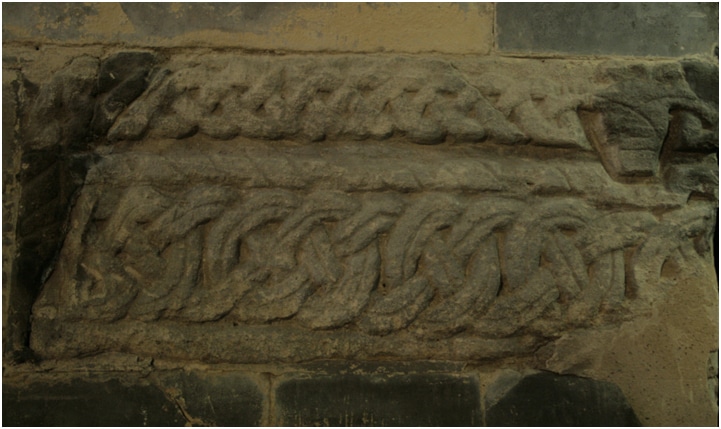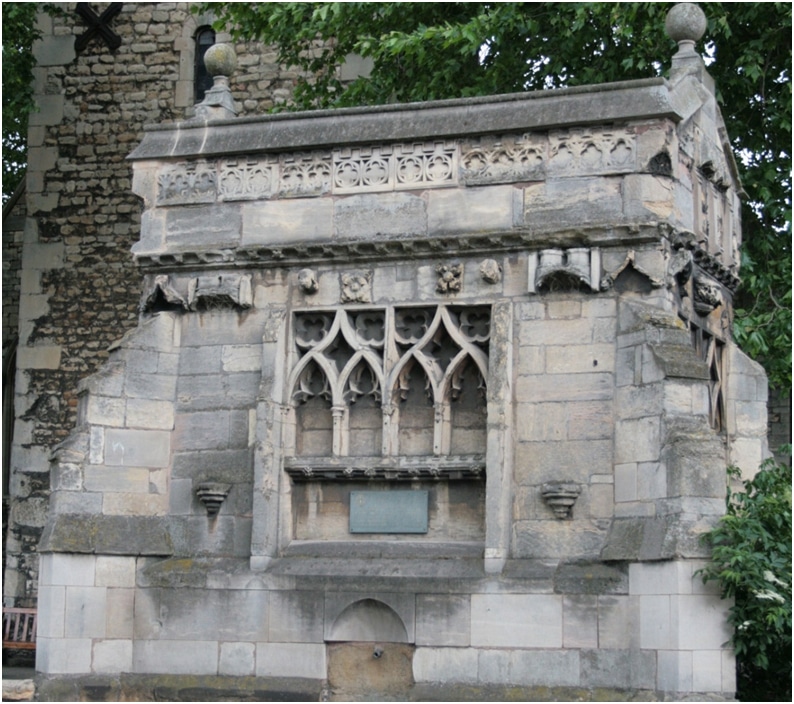Over 1,000 years ago Ertig built a stone tower on this church ’to the glory of God and St. Mary’. Since Saxon times this church has stood at the commercial centre of Lincoln serving each generation.
Many other churches have been founded, including our cathedral, and many others have disappeared, but only St Mary le Wigford has a record of unbroken service, being one of only two churches to remain open after the City was devastated by the Siege of Lincoln in 1644.
The history of our City is written in the stones of St Mary le Wigford and it contains many fragments from churches now gone. We hope you will visit our fine church to explore its history firsthand, we have information below as well as a downloadable PDF and please take a look at our interactive virtual tour which has historical information.

The church in the late 10th century possibly consisted of a timber-framed Nave and Chancel, which were then replaced in stone. The tower was added in the early 11th century. The current Nave, North aisle and Chancel date from the 13th century and the South aisle is a Victorian addition when the railway line came to Lincoln just to the south of the church.
In the 1970s, to meet the needs of the Lincoln City Centre Ministry, the door in the West face of the tower was closed, the interior face of the tower glazed to create an office and two rooms were built in the South Aisle. The church hall, reached via the Vestry, was built at this time.
We are currently engaged in a substantial re-ordering of the church and church hall to make it fit to serve the City into the 21st century and match the substantial works around us in the City Centre and you will find details and plans inside the church.

The Early Church
It is possible that a timber-framed church was the first building to stand on this site, in the late 10th century (circa A.D. 980).
Inside the church, on the southern side of the Tower Arch, can be seen a late 10th / early 11th century Anglo-Saxon tomb cover (a “Mid Kesteven” type) which seems to been incorporated during the 11th century tower’s construction.
This tomb cover (right) and two other small late 10th century fragments above the door of the 19th century South Aisle (outside) help to confirm the existence of a thriving Christian community on this site, at least from the 10th century, to the present day.


Dedication Stone
Outside, on the west face of the tower, a Roman memorial stone has been re-used as the church dedication stone.
The lower original (Latin) inscription on the stone reads: “Dis Manibus / nomini Sacri / Brusci fili(i) civis / Senoni et Carsso / unae coniugis / eius et Quinti f(ilii)”. It is translated as follows: “To the departed spirits and to the name of Sacer. Son of Bruscus, a citizen of the Senones and of Carssouna, his wife and of Quintus, his son…”
Reading upwards, from the base of the triangular (gabled) top of the stone, the later (Old English) inscription reads: “Eirtig me let wircean / and fios godian / Criste to / lofe and sancta / Marie XP”.
It is translated as follows: “Eirtig had me built and endowed to the glory of Christ and St. Mary, XP”.
The name Eirtig seems to indicate, along with the architecture of the tower, that the Old English inscription was written in the 11th century.
In Saxon times the law stated that, ‘If a merchant thrived so that he fared thrice over the wide sea by his own means; then he was thenceforth of thegn-right worthy’. The ‘wide sea’ was the name of the North Sea, as opposed to the English Channel which was the ‘narrow sea’. From this it appears that Eirtig was probably a successful merchant who traded from the old Roman port on the Brayford across to the continent.
Monuments
There are various monuments within the church including the tomb covers of Ranulf de Kyme and his wife which were rescued from the wall outside by the Conduit. The alabaster Grantham tomb has had an interesting history (image right).
It is dedicated in memory of Sir Thomas and Lady Grantham. Generations of the Grantham family have given service to both the Church and the City and they had resided within the parish, in Brauncegate, which was later to be renamed Grantham Street, in honour of the family.
The tomb, with crests on its side and supine (sleeping) figures on its top, was originally placed in the church of St Martin at Dernstall (Lincoln). It was severely damaged in 1644, during a Parliamentarian attack on the City. The tomb had been moved to the tower’s basement but it was still damaged by falling debris.
The tomb then disappeared from Lincoln and reappeared in Sussex where a Mr Justice Grantham had it installed in his parish church to give credibility to his claim of a noble background!
It was returned after a judgment by the Consistory Court and in the 19th century, the tomb was moved to the replacement St Martin’s church (West Parade), before being moved again, to St Benedict’s. It was later placed in the safekeeping of a member of the family who offered it to Lincoln Cathedral, where it remained (in their workshop) to be restored. The tomb was finally moved again to the church of St Mary-le-Wigford with St Mark.


The Conduit
Situated on the western church yard boundary, the Conduit served as a water tank from 1540 to 1906. It was constructed using architectural fragments taken from the De Kyme family chantry which were brought from the nearby Friary site at St Mark’s (now under St Mark’s Square and Debenhams).
The Conduit is not in its original 1540 position. A decision was taken in 1864 to move the conduit away from the High Street (eastwards) to the position where it now stands.
It continued in its role as an active Conduit, between 1864 and 1906. This and other Lincoln conduits were more trusted as a water supply by the local populace, rather than the mains water, during the typhoid outbreak of 1904-1905. English Heritage classifies the Conduit as a Grade 2 listed structure.
The Corporation Chandelier
During the mid 17th century, the Puritans removed many traces of Anglicanism from the churches of Lincoln. The church of St Mary-le-Wigford was one of the very few that managed to avoid the same fate.
After the Siege of Lincoln in 1644, when the Roundheads captured the City, most of the city’s churches were damaged or destroyed. St Peter-at-Arches and St Mary-le-Wigford, were the only “below hill” churches to hold a service every Sunday.
In recognition of this fact, The City of Lincoln Corporation presented a magnificent brass chandelier to the church of St Mary-le-Wigford, in 1720, which now hangs in the Choir.


